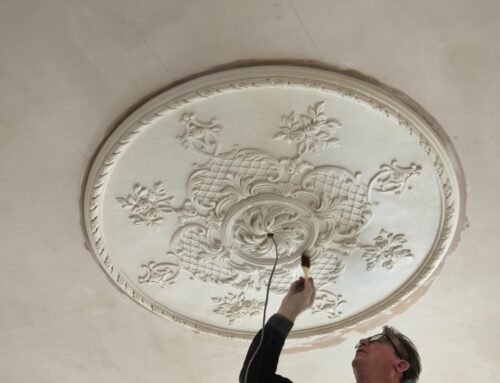At Modillion, we understand that decorative plaster mouldings are more than mere embellishments; they are integral to your home’s character and charm. Regular maintenance and proper cleaning are essential to ensure these features remain pristine and continue to enhance your interiors. Drawing from our extensive experience crafting and restoring plaster mouldings, we offer the following guidance to help you care for these intricate details effectively.
Understanding Decorative Plaster Mouldings
Decorative plaster mouldings, such as cornices, coving, ceiling roses, and corbels, are architectural elements crafted from gypsum plaster. They serve aesthetic and functional purposes, adding elegance and sophistication to ceilings, walls, and doorways. At Modillion, we specialise in creating and installing bespoke designs hand-crafted by our skilled plasterers using traditional methods.
The Importance of Regular Maintenance
Over time, plaster mouldings can accumulate dust and dirt, leading to a dull appearance. Environmental factors like humidity and temperature fluctuations may also cause cracks or structural issues. Regular maintenance not only preserves the aesthetic appeal of these features but also prevents minor problems from escalating into costly repairs. Proper care ensures that plaster mouldings remain a standout feature in your home for years.
Tools and Materials Needed for Cleaning
To clean plaster mouldings effectively without causing damage, we recommend using the following tools and materials:
- Soft brushes: Ideal for dusting intricate designs without scratching the surface.
- Microfibre cloths: Gentle on plaster surfaces and effective in removing dirt.
- Mild detergent: A gentle cleaning solution that won’t harm the plaster.
- Cotton swabs: Useful for reaching into small crevices.
- Step ladder: Ensures safe access to high areas.
Avoid using abrasive materials or harsh chemicals, which can damage the delicate plaster surface.
Step-by-Step Cleaning Process
- Dusting the Surface: Gently wipe the mouldings with a soft brush to remove loose dirt and debris. Regular dusting prevents buildup that can become ingrained over time.
- Preparing a Cleaning Solution: Mix a small amount of mild detergent with warm water. Ensure the solution is gentle to avoid damaging the plaster.
- Gently Wiping the Mouldings: Dampen a microfibre cloth with the cleaning solution and gently wipe the mouldings. For intricate areas, use cotton swabs to clean small crevices. Avoid over-wetting the plaster to prevent moisture damage.
- Drying Techniques: After cleaning, allow the mouldings to air dry completely. Ensure proper ventilation to facilitate drying and prevent moisture-related issues.
Preventing Common Issues
To maintain the integrity of your plaster mouldings, it’s vital to prevent common issues:
- Moisture Damage: Keep the indoor environment well-ventilated to prevent humidity buildup, which can lead to mould growth and plaster deterioration.
- Physical Impacts: Be cautious when moving furniture or performing activities near the mouldings to avoid accidental bumps or scratches.
Addressing Stains and Discolouration
If you notice stains or discolouration on your plaster mouldings:
- Identify the Cause: Determine whether the stain is due to water damage, smoke, or other factors.
- Safe Removal Methods: For minor stains, gently clean the area with a mild detergent solution. For persistent stains, consider consulting a professional to avoid causing further damage.
Repairing Minor Damages
Over time, plaster mouldings may develop cracks, chips, or discolouration. These issues can be caused by various factors, including settling of the building, temperature fluctuations, or moisture exposure. Small cracks can often be repaired with a suitable filler, applied carefully to match the original texture of the moulding. For more significant damage, professional restoration may be required to restore the mouldings to their former glory. Water damage, in particular, should be addressed promptly to prevent further deterioration. Suppose your mouldings have become faded or discoloured. In that case, a fresh coat of paint can help to restore their original beauty. Still, it is essential to use paint compatible with plaster surfaces.
Protective Measures for Longevity
To extend the lifespan of your plaster mouldings:
- Applying Sealants: Consider using a breathable sealant to protect the plaster from moisture and environmental pollutants.
- Regular Inspections: Periodically inspect the mouldings for signs of damage or wear, addressing issues promptly to prevent further deterioration.
When to Seek Professional Assistance
While regular maintenance can address minor issues, certain situations require professional expertise:
- Extensive Damage: If the mouldings have significant cracks, chips, or structural issues, professional restoration is advisable.
- Historical Accuracy: Maintaining the historical integrity of plaster mouldings is crucial for period properties. Professionals can ensure that restorations are done using the original designs.
At Modillion, we specialise in restoring and creating exquisite plaster mouldings, ensuring they remain a stunning focal point in your home for years.
Conclusion
Maintaining and cleaning decorative plaster mouldings is essential to preserving your home’s elegance and historical significance. With regular care and the proper techniques, these beautiful architectural features can continue to enhance your home for many years. At Modillion, we are committed to helping you maintain the charm and integrity of your plaster mouldings. Whether you need advice on cleaning or professional restoration services, we are here to help you keep your home’s decorative elements pristine.







Leave A Comment